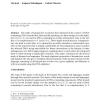Free Online Productivity Tools
i2Speak
i2Symbol
i2OCR
iTex2Img
iWeb2Print
iWeb2Shot
i2Type
iPdf2Split
iPdf2Merge
i2Bopomofo
i2Arabic
i2Style
i2Image
i2PDF
iLatex2Rtf
Sci2ools
ACTA
2007
2007
The syntactic monoid of hairpin-free languages
The study of hairpin-free words has been initiated in the context of DNA computing. DNA strands that, theoretically speaking, are finite strings over the alphabet {A, G, C, T} are used in DNA computing to encode information. Due to the fact that A is complementary to T and G to C, DNA single strands that are complementary can bind to each other or to themselves in either intended or unintended ways. One of the structures that is usually undesirable for biocomputation, since it makes the affected DNA string unavailable for future interactions, is the hairpin: if some subsequences of a DNA single string are complementary to each other, the string will bind to itself forming a hairpin-like structure. This paper continues the theoretical study of hairpin-free languages. We study algebraic properties of hairpin-free words and hairpins. We also give a complete characterization of the syntactic monoid of the language consisting of all hairpin-free words over a given alphabet and illustrate i...
Related Content
| Added | 08 Dec 2010 |
| Updated | 08 Dec 2010 |
| Type | Journal |
| Year | 2007 |
| Where | ACTA |
| Authors | Lila Kari, Kalpana Mahalingam, Gabriel Thierrin |
Comments (0)

